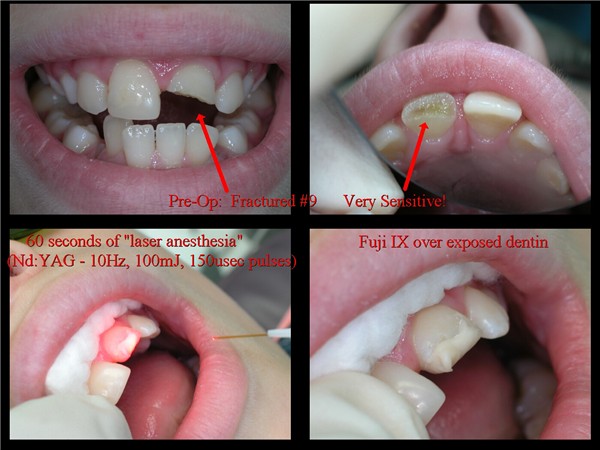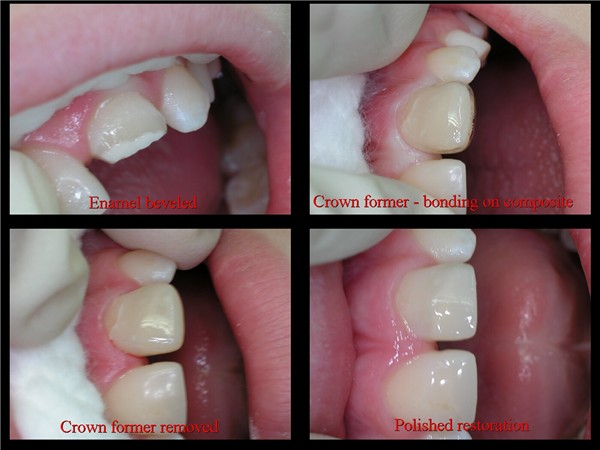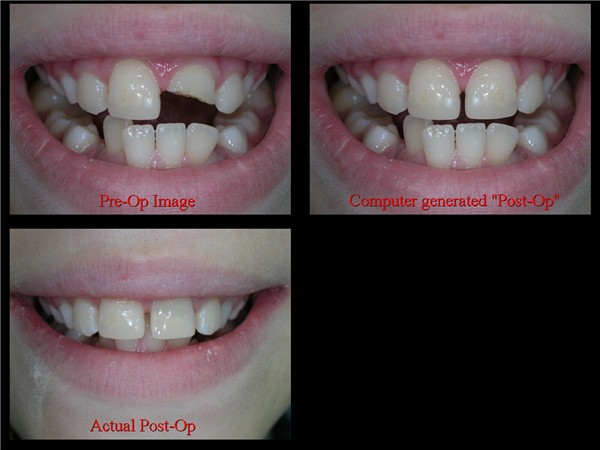Forums › Laser Treatment Tips and Techniques › Hard Tissue Procedures › Nd:YAG anesthesia
- This topic is empty.
-
AuthorPosts
-
kellyjblodgettdmdSpectatorDammit! I just did a whole write up and accidently bumped something and it all disappeared! Here’s the short version.
11y.o. boy – fractured #8 & 9. Neither teeth were able to be anesthetized @ previous dentists office, despite 5 different attempts (attempting to re-bond the fractured piece of #9 – it never held).
The patient has gone with nothing covering#9 for 6 months now, as he is so fearful of needles now. Tx of choice: use Nd:YAG @ 10Hz, 100mJ and 150usec pulses for 60 sec at a distance of about 1.5cm. The tooth was tested w/ cold and by touching exposed dentin lightly on the incisal fractured portion. Tooth definitely vital! I lased the tooth to “anesthetize” the nerve. I then used a course polishing disc to create a long deep bevel to try to gain a ton of bond strength. The patient didn’t feel anything! He couldn’t believe it. I used Fuji IX to cover the exposed dentin prior to beveling. After reading Graeme Milicich’s research on GI bonding, I am confident that if this thing ever fractures again, at least he’ll have a thin coating of GI attached to the dentin. The pictures pretty well speak for them selves. I’d love some feedback or questions! Thanks.



Kelly
BenchwmerSpectatorKelly,
Great results. I’m sure everyone is happy.
My thoughts are if you are covering the dentin w/ GI, the patient wouldn’t have any pain anyway, why the laser anesthesia?
You could have applied a self-etching DBA, to desensitize and seal if you had some pain before the procedure you did or conventional etch and bond.
Loved the outcome, I just don’t see the need for the laser (or GI).
Jeff
Robert Gregg DDSSpectatorKelly,
Nice thinkning and application of “pulpal sedation” using FRP Nd:YAG.
I can understand the need for some analgesia here. Dang thing was very sensitive…..
Once you obtained analesia, could you approach the tooth and perhaps dentin etch with the Nd:YAG? That would give a better bond strength to dentin, and skip the need for GI.
Also, why the Nd:YAG and not the Waterlase for analgesia?
Great case! Great result! Thanks for posting.
Bob
BenchwmerSpectatorBob,
It was sensitive 6 months ago.
Not after you cover the dentin w/ GI
I thought the same thing, why not the “Swiss Army” laser to treat all phases of this case.
Jeff
AnonymousGuestQUOTEQuote: from Robert Gregg DDS on 9:55 am on Oct. 29, 2004
Kelly,Nice thinkning and application of “pulpal sedation” using FRP Nd:YAG…
Also, why the Nd:YAG and not the Waterlase for analgesia?
Which brings up a question in my mind- since the ndYAG wouldn’t lower pulpal tempature (like a erbium with the water spray) does this mean we may be able to rule out decreased pulpal tempature (and thus slower chemical reactions along the pain transmisssion pathway) as a possible mechanism of pulpal analgesia?
I also see Kelley used 10hz, not the 20hz that many say is the rate of neuron firing, is the 10 enough to block the pathway to other impulses?
Just thinking out loud, but Kelley’s case raises some interesting possibilities.
kellyjblodgettdmdSpectatorYou know guys, I covered all of the details in my first write up, and unfortunately I was too tired to type it all again after I lost the first batch – oops!
Anyway, the tooth was still extremely sensitive when I treated it. The patient had developed a habit of curling his lip over this tooth to protect it even from breathing. My intention for using Self-cure GI was to create a seal only possible with GI, not with composite. I used the Nd:YAG, rather than the Er,Cr:YSGG because I’ve found it to be more selective for pulpal analgesia. After all, the hyperemic pulp will absorb that wavelength very well, while being absorbed by tooth hardly at all. From a physics stand point, the Nd:YAG makes a lot more sense for “numbness” than an Er laser, I think.
Additionally, I didn’t want to treat the dentin w/ the Nd:YAG directly, since I was applying the 10% poly-acrylic acid to prep the dentin for receiving the auto-cure GI. Generally, I don’t count on “laser etching” because of its variability. I don’t believe it’s possible to maintain a consistent power density over all surfaces, and therefore you end up with variably affected dentin (or enamel if using an Er.).
Another thing I unfortunately forgot to mention: The patient had no GI on his tooth when he came to me. True, in the picture where I’m holding the laser over the tooth, there is GI there (I forgot to take a picture when I did the real anesthesia, so I fudged one after the GI was on.)
The point I was trying to make was this: Prior to Tx w/ the Nd:YAG, I couldn’t even touch the tooth without the patient jumping. After the “anesthetic” laser Tx, we were able to apply the 10% PA Acid, rinse, mildly dry and place the GI with the patient feeling nothing. I still have very little idea of exactly how this works, but I know it works, very well.
Thanks for the input! I’d be glad to hear your feedback on these thoughts. Thanks.
Kelly
BenchwmerSpectatorKelly,
You didn’t say you couldn’t touch the tooth, before tx.
I figured after 6 months, no problems.
Treating the exposed dentin w/ self-etching dentin bonding (Adper-Bond, Clear-Fill Bond) will seal the tubules. disinfect and allow acid etch of the enamel after the DBA.
Your tx was a good indication for the use of the Nd:YAG. It also disinfected the dentin before tx.
I use the PerioLase in all near-exposure and pulp caps on dentin to remove any remaining caries and to disinfect and etch.
Looking good.
Jeff
kellyjblodgettdmdSpectatorThanks Jeff. Nice new pic, by the way!
Kelly
doctorbruSpectatorJeff,
What setting do you use to disinfect dentin, remove caries and etch ? Is there any scientific evidence this really works ?
Bruce
BenchwmerSpectatorBruce,
I am a Kanca believer. My pulp caps for the last 15 years have been acid etch, dentin bonding agent, then flowable composite, then hydrid composite restoration.
Six years ago with the PerioLase, I would lase exposures to stop any bleeding, remove any remaining caries and disinfect 3.0W 20Hz 150usec. Then acid etch and DBA.
With self-etching DBA I go right from lase to DBA to composite. Now with the MVP-7 I use 3.6W 20Hz 100usec.
Read Kanca’s literature for his science on dentin bonding or Bertalotti for the West coast guys. The Nd:YAG has FDA clearance for dentin caries removal. The laser use in deep carious lesions, led to use when a small exposure occurred during mechanical caries removal. Success is measured in a week for pain or lack of and at nine months for vitality.
Studies on Caries removal check the Joel White studies from the early 90s, Bacterial reduction of contaminated dentin, pulpal responses to Nd:YAG on dentin, etc. There is a bibliography in the Day 1 book from Laser Boot Camp.
Jeff
doctorbruSpectatorThanks Jeff,
I spoke with John Kanca at his Apex booth at the GNYDM yesterday and he and Gerry Geister(spelling) told me that they were planning on releasing a paper showing decreased bond strength on laser treated surfaces.
John is one very smart puppy. I ordered his simplicity, interface and anchor cement to try. Everyone is raving about his materials.Thanks for your response, very informative.
Bruce
BenchwmerSpectatorBruce,
I like using air abrasion after laser to prepare lased anterior teeth for bonding. It removes the “white residual enamel”, gives me the perfect clean surface to etch and bond or bond with a self-etching DBA. I have gotten away from Kanca’s endorsed roducts, but have maintained his bonding principles.
Jeff
doctorbruSpectatorJeff, Maybe I should dust off my Kreativ Mach IV. I got away from using it when I purchased the waterlase a few yars ago. Also did not like it when they started selling grey powder only. Interestingly, John kanca loves air abrasion.
Bruce
Robert Gregg DDSSpectatorBruce,
You can use the DENTIN etch setting on the Periolase and get a very good bonding surface and clean of the enamel dust.
Bob
BenchwmerSpectatorBruce,
Try Danville Engineering to buy your abrasives.
I also use the AA for a diagnostic tool for occlusal caries/sealants. My assisitant told me working for me is like Thanksgiving Dinner everyday, you have to get out all the utensils, plates, pots etc. Whatever works.
Jeff -
AuthorPosts
